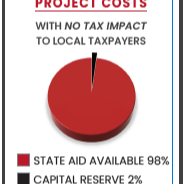Questions and Answers
Q. What is a Capital Project?
A. It is like home improvements for schools. By NYS Law, the school district inspects its property regularly, working with an architect to maintain a five-year, capital improvement plan. Some issues require immediate attention, while other repairs and upgrades can be spread out over time. This is done in much the same way a homeowner utilizes savings or obtains an improvement loan to fund major repairs, such as a roof. For school districts, this is called a “Capital Project”; in our case we would enter into a 15-year bond in order to pay for the project over time, to coincide with expected State Building Aid payments.
Q. Why a Capital Project versus operation and maintenance?
A. The State Education Department (SED) encourages school districts to undertake a routine schedule of capital improvements to maintain their facilities and grounds. To further encourage enhancing schools, SED reimburses districts through “Building Aid” for capital projects (different from “Operating Aid”). SED pays a percentage of capital project costs, in our case 98%, and the district pays the balance known as “Local Share”. Through this project, the District projects to receive $1,891,644 per year in additional state aid from 2028 to 2042 during repayment of the loans to pay for the project. If facility construction work were to be completed out of the Operations and Maintenance budget, there would be NO STATE AID (100% Local Share).
Q. Why doesn’t the District just include these items in the annual budget?
A. By creating a Capital Project from the work that needs to be done, the District will receive 98¢ back on every dollar spent. Without that reimbursement from NY State, the entire cost would rest with the tax-payers. Major construction cannot be absorbed into the annual budget and is best funded and paid over several years.
Q. What is included and why is the project needed?
A. This project includes improvements to aging roofs, upgrades to the cafeteria and kitchen, parking lot renovations, locker room conversion and renovations, generator replacement, STEAM room additions and a new bus garage lift. Materials like roofing become costly to maintain as they age, and more prone to failure at their current age. We are looking to add more cafeteria seating which will allow us to seat more students during meal times. Currently at breakfast, we have students eating on the bleachers in the gym due to lack of space in the cafeteria. Kitchen upgrades include replacement of aging and inefficient equipment and serving lines. Locker room expansion and conversions will include converting the current metal shop into locker rooms for the current elementary gym with the intention of changing that gym to a middle school gym and converting the middle level gym to elementary. Middle school locker room space will be converted to small classrooms and conference areas. A STEAM room addition will include construction of two new rooms and expansion of our current greenhouse. Site work will include expansion and redesign of the current south parking lot and parent pick-up area to allow for better traffic flow and address safety issues. Site work will also include replacement of backstops and addressing drainage issues on some of the athletic fields.
Q: Will this project complete our capital improvement needs?
A: No. Our buildings are aging, and our facility requirements, like your home, will require on-going updates to meet our needs. Our facilities host over 1,000 people every day…students, staff and visitors...walking on our floors, opening and closing our lockers, doors and windows, playing in our gyms, eating in our cafeterias, driving and parking on our roads and in our lots, and playing on our play fields. Normal wear and tear and the effects of time take their toll on our buildings and grounds. Acting with fiscal responsibility, we wish to minimize the cost to our taxpayers, while maintaining safe, healthy and appropriate facilities and learning environments for our students, staff and community.
Q. What is the total cost of the proposed project, and what is the estimated average cost to district taxpayers?
A. The total project referendum has been established at $21,605,900. This is estimate includes construction and incidental costs. We are estimating conservatively to cover for inflation and any unforeseen expenses. Incidental costs include architect, construction management/clerk of the works, legal and other fees.
There will be no increase to local taxes to pay for this capital project. It will be funded through state building aid, Excel Aid, debt service fund and capital reserve.
Q. Why is voter approval needed?
A. Voter approval is required whenever it is necessary to maintain currently levied tax amounts, increase the tax levy, and establish or expend funds from capital reserves. Money placed into capital reserves must be earmarked for specific projects, and can only be spent on those projects for which it was intended, via a voter referendum.
Q. Why now?
A. The district has retiring debt service from prior capital projects that will be paid in full after the 2028-29 and 2029-30 fiscal years. The proposed project will come on line to coincide with the fall off and this provides an opportunity for the layering in of a new project without impacting taxpayers. The District has also set aside funds in a dedicated capital reserve to address improvements and has $220,898 in EXCEL Aid remaining. This EXCEL aid can only be used for capital improvement projects that meet certain criteria which this project does. Both the reserve and the EXCEL Aid will reduce the amount needed to finance. Lastly the District has identified items that are eligible for State building aid. The District’s building aid ratio is 98% and a majority of the cost of the project will come back to the District in the form of this building aid. With the high building aid, other sources of funds and the falling off of old bond issues, the timing is right to take on a new project without impacting the taxes.
Q. What happens if the Capital Project is NOT Approved?
A. Costs could go up. The financing for this project will allow the Brushton-Moira Central School District to spread payments for the work over several years to correspond with the building aid that we receive from the State. If voted down, several of the items will need to be addressed in the annual operating budget thus taking funds away from our academic programs and overall operations. Items paid for out of annual budget would generate NO State Building Aid (100% local share).
Q. Isn’t State Aid just my tax dollars too?
A. Yes, it is. The New York State Legislature has given all Districts in the state an opportunity to use tax dollars to enhance their communities through school building improvements and renovations. This is an opportunity to keep some of those tax dollars in our own community and improve the educational setting for our children.
Q. If the project is approved by voters, when will the work be completed?
After voter approval, the plans and specifications will need to be completed by the architects and engineers and will be submitted to New York State for approval (SED issues our “building permit”). This process and approval from the state can take a year or more. The actual construction period is dependent on SED approval, but we are hopeful that it will begin in spring of 2026 with completion in the summer of 2027.





